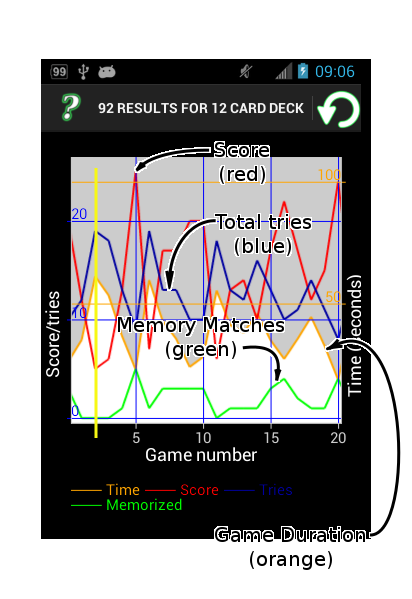
Figure 1. The action bar controls
Sushi Concentration is a solitaire version of Concentration. Concentration is known by many names including Memory and Shinkei-suijaku. This Wikipedia page explains the history of the game and strategy.
The object of the game is to turn all of the cards face up. Pick a card and it will turn up. Pick a second card and if the two cards match, they will both stay up and are masked. If they don't match, when you pick the next card, the first two cards will turn back to face down.

To start a new game, click the "New Game Button." When you click your first card, the "Status Area" will update showing score, elapsed time and number of tries.
The tablet pull-down menu allows you to select the number of cards for the program to deal. You can select even numbers between 8 and 18.
You start with 1 point for each card.
This is a "Memory" game. The better your memory of previous card locations is, the better your score. But remember -- research has shown that most people can't remember more than 7 things (or 14 cards) at once.
To view your previous scores, select "Show History Chart" from your pull-down menu. This displays the history for the games with the same number of cards as you are currently using. For example, if you are currently using 12 cards when playing the game, you will see the saved history for 12 card games. To see the history for games with a different number of cards, select that number of cards using the pull-down menu.
The game saves a history for the most recent 100 games. On the chart, the most recent game is on the left. To see older games, scroll the graph. To see a higher or lower resolution, use the "pinch-zoom" feature of the graph.
The color key at the bottom of the graph tells the meaning of the lines on the graph. Note that the 3 on the left are score or number and those on the right are seconds. Score is indicated in points and memory-match and tries are the number. Game duration is seconds.
For example, the game indicated by the yellow line in Figure 2 is game 2 with a score of about 5, no memory matches, almost 20 tries and lasted about 60 seconds.

After about 2 weeks you will be given the opportunity to upgrade to the non-free version. If you enjoy the game enough to spend $1 on it, please upgrade. It'll help my caffine addiction :)
The free and non-free versions of this application are essentially the same application except that
Credits and Licensing info
Sushi images were created by my friend Michiko who resides in Tokyo Japan and edited for use in this application. They are covered by the Creative Commons 4.0 license. You can copy, redistribute and transform them for personal or commercial use. Please give appropriate credit.
For higher resolution images, please contact the app's creator.This application uses a graphing package created by AChartEngine. I found it to be a really useful and well written library. It's distributed under the Apache version 2 License . It is free to use in commercial or free applications.


